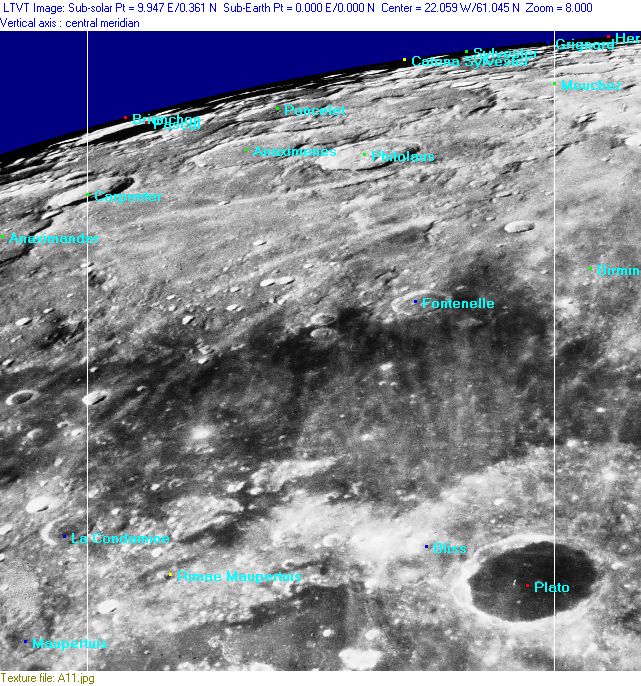Rükl 3
Contents
Rükl Zone 3 - PLATO
Neighboring maps on the Rükl Nearside Map:
| 3 |
||
Photographic Map
(This map is based on an Earth-based photograph that has been computer-corrected to zero libration. The vertical white lines indicate the left and right boundaries of the Rükl rectangle)

Background image source
Nearside Named Features
- Anaximenes
- Bartlett (a disallowed name from H.P.Wilkins for a crater near Fontenelle).
- Bliss (Plato A, once called Jackson-Gwilt by W.R.Birt).
- Brianchon
- Catena Sylvester
- Dorsa La Condamine B (an unofficial name from D.Caes for the system of wrinkle ridges north and northeast of La Condamine B, in the western part of Mare Frigoris).
- Dorsum Fontenelle (an unofficial name from D.Caes for the arc-shaped wrinkle ridge running east-southeast of Fontenelle, and touching the southeastern part of its rim).
- Dorsum Fontenelle B (an unofficial name from D.Caes for the straight wrinkle ridge southwest of Fontenelle B, running toward Fontenelle X).
- Dorsum Plato D / Dorsum Capraria (two unofficial names from D.Caes for the wrinkle ridge running west of the bowl-shaped crater Plato D and across the hill Teneriffe Epsilon, aka Insula Capraria, thus named by Hevelius).
- Fontenelle
- Fontenelle Epsilon (see also the Fontenelle hills).
- Fontenelle hills (an unofficial name from D.Caes for the cluster of hills east of Fontenelle) (note: there are Greek letter designations for most of these hills on chart 2 in the Times Atlas of the Moon).
- GRAIL (impacted on December 17, 2012, between Mouchez and Philolaus).
- Grignard
- Handcuffs/ Twisted Arcs (two nicknames from D.Caes for a peculiar kind of formation north of La Condamine, see also Chart 2).
- Insula Capraria (J.Hewelcke's disallowed name for the hill Montes Teneriffe Epsilon, which is the most northern part of Montes Teneriffe, see Chart 11).
- Insulae Calabraria (J.Hewelcke's disallowed name for a certain spot in Montes Teneriffe) (E.A.Whitaker seems not certain about that one).
- J. Cassini (discontinued IAU name).
- Madler's Square (unofficial name).
- Mare Frigoris (the part of it north-northwest of Plato) (Van Langren's Mare Astronomicum, J.Hewelcke's Mare Hyperboreum).
- Mare Imbrium (the most northern part of it, at the chart's lower margin, west-southwest of Plato).
- Pascal
- Philolaus
- Philolaus Escarpment (an unofficial name for the scarp-like feature southeast of Philolaus, see the moonmap of Rand McNally).
- Plato (Van Langren's Lacus Panciroli, J.Hewelcke's Lacus Niger Major).
- Plato M (west of Bliss) (a high-albedo bowl shaped crater with bright ejectablanket which shows some sort of lightblue'ish coloration when it is observed during Full Moon circumstances).
- Plato Tau (Van Langren's Arati) (now where the hell is Plato Tau?).
- Poncelet
- Poncelet's mini-Wargentin (a nickname from D.Caes for the Wargentin-like crater at the south-southeastern part of Poncelet's rim).
- Rafelon (a rather strange name from G.H.Lindop for Plato F) (see also Additional Information below).
- Regio Hyperborea (J.Hewelcke's disallowed name for the northern limb region).
- Ride (NASA Shuttle astronaut Sally Ride) (proposed name for the impact site of GRAIL).
- Rimae Maupertuis
- Sylvester
- Terra Pruinae (Riccioli's discontinued name for the region west of Plato) (Van Langren's Terra Laboris).
- Terra Siccitatis (Riccioli's discontinued name for the region north of Mare Frigoris) (Van Langren's Terra Honoris).
- Vallis Pascal (an unofficial name from D.Caes for the valley north of Pascal).
- Vallis Sylvester (an unofficial name from D.Caes for the valley between Brianchon and Sylvester).
An extra "name":
- The Bliss boundary (according to A.J.M.Wanders, the boundary between Riccioli's Terra Grandinis and Terra Pruinae runs immediately west of Bliss, aka Plato A) (it is not known if Riccioli thought the same way as A.J.M.Wanders, we could only guess...).
Farside Named Features
(The following features are not formally included in the present Rükl rectangle, but they are adjacent to it and their centers are less than 10° beyond the mean limb -- so they may be seen here in whole or in part with a favorable libration)
Lettered Crater Locations
(click on the thumbnails to display full-sized images; use browser BACK button to return - the dashed white lines are the midpoints of the Rükl zones)
Full zone with lettered craters:
Lettered craters by quadrants:
| North West |
North East |
| South West |
South East |
Additional Information
- Other online descriptions of features in this Rükl map section:
Geoffrey Hugh Lindop's possible revolution in lunar nomenclature
On page 47 of the january 1979 issue of Spaceflight (a well-known magazine for rocket and spaceship addicts) appeared a curious letter by a certain Geoffrey Hugh Lindop, who wanted to change the entire catalog of lunar nomenclature into some sort of lettered code system. In his letter, he included two examples of his system: RABAKUW (the IAU's Bianchini W) and RAFELON (the IAU's Plato F). After reading his letter about a dozen times, I still don't understand his method. G.H.Lindop's system could be a VERY interesting one (!), but he didn't give much explanation... (or rather: "a much too complicated" explanation). (the two examples were not enough to comprehend Lindop's way of thinking). - DannyCaes Jan 7, 2016




